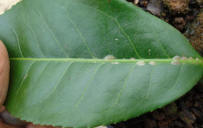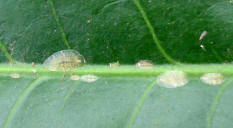tea notes
These notes are maintained by
Ben Discoe (who also has a
tea farm)
Pests and Diseases
- Not much is known yet about what might attack tea plants in Hawai'i.
The common rose beetle has been mentioned as a potential pest. Some
kinds of leaf blight can be an issue. Both of those have been seen at
Mealani, but Milton says they were not major problems.
- General reference:
APS Plant
Pathology: Diseases of Tea lists 70 species.
- CTAHR publication PD-33 Oct. 2006:
Identification Guide for Diseases of Tea (pdf)
- Descriptions and pictures of: Algal leaf spots, Brown blight, grey
blight, Blister blight, Horse hair blight, Twig dieback, stem canker.
- CTAHR publication PD-34 Oct. 2006:
Zinc
Deficiency in Tea (pdf)
- One page, shows a picture of what can happen with insufficient Zinc:
new leaves are small and bunched-up.
- I have encountered the following problems:
- Aphids. Large, dark aphids are brought in by ants. I was able to
control this by repeatedly removing (squishing) the aphids and ants by
hand, and cutting off access by ants to the greenhouse tables as well as
i could. Eventually, the ants gave up; in January 2007, aphids in our
greenhouse are rare.
Dwight Sato says these are the common
melon aphid:


- Some kind of armored scale, an insect which attacks the nodes
and stems, weakening the plant until it dies. This especially likes to
attack my Yutaka Midori, Bohea and CSO, although it's appeared on all of
the 5 USDA cultivars. Here are pictures of diseased plants and close-up
of the organism. It takes a long time to kill the plant. Some have had
the scale on them for more than a year, dying very slowly. Once a plant
gets it, i have not seen any recovery.







It's not "tea scale" (Fiorinia theae) which grows thinly on
leaves, not thick on stems. I also consulted Ghosh Tea Cultivation
and my plants do not match the descriptions of any of the 8 stem
diseases in that book.
Dwight Sato says: "[Keep the plants well-fertilized and healthy so
they're not as susceptible to pests like this.] For younger potted
plants, if you don't have much, simply and gently wipe or scrape them
off the stem with your finger. A balanced nutrient program appears to
be the key factor."
I found some general guidelines at
How to
Manage Pests in Gardens and Landscapes: Scales although it only
talks about scales commonly found in California. Of those, my scale
looks most like their pictures of
greedy
scale (Hemiberlesia rapax). Another reference calls greedy
scale "tropical camellia scale" so that sounds very likely.
Bumps on My Plants is a good introductory page on scales.
- I've seen a little bit of the blights and spots mentioned in the
CTAHR publications, although they are relatively minor, mostly on plants
that have already been weakened by the scale.
- Mike Longo writes:
- Generally, I would say that Camellia
Sinensis has a hard time in pots, and they are more vulnerable to pests,
especially when they are in a greenhouse. [..] Once you get a bloom of
anything, it quickly spreads throughout the greenhouse. We tried soap
sprays and neem with some success. We even tried ladybugs and lace wing
insects at one point. Ultimately it took taking the plants out of the
greenhouse and planting in the ground to correct the problem. I think
that the small rooted Tea cuttings are particularly vulnerable to these
problems and it can be real effort getting these plants to grow large
enough to get them planted in the field.
In our field, we have found that insect
problems come and go, but that plants usually grow out of the damage. We
have had temporary, minor problems with rose beetles, aphids, scale and
spider mites. None of these problems lasted for very long at all. For
example, spider mites can make the whole plant, usually just the smaller
plants, look dead. The leaves turn completely brown and the plants look
like you should just throw them out. However, in every case where mites
had caused this kind of damage, the plants grew out of the problem in a
couple of months, with no treatment at all. I have seen spider mite
damage also at Mealani, a couple of years ago, in the field on some
small plants. When I returned for a visit there a few months later, the
plants were all healthy and green again and I was told that they also
just grew out of it with no treatment. I think that we are finding that
Camellia Sinensis, once established in the ground in fairly well-drained
soils, is proving to be a very hardy and resilient plant in Hawaii.
- That indicates that a good strategy to avoid pests would be to move tea
out of the greenhouse and into the ground as soon as possible. In fact, in
one case a grower even put some baby tea plants in oasis cubes directly into
the ground, and they survived and established!
- February 9, 2007. I found more scale growing on a freshly planted
Benikaori rooted cutting (only one plant).
- These are growing on the top of the leaf, rather than on the stem,
and they look rather different than the previous scales, although that
might be because they are fresh:
-


- I was able to easily scrape them off with a plastic plant label.
Their bodies were soft, so might be either a soft scale or a very
immature hardened scale.

